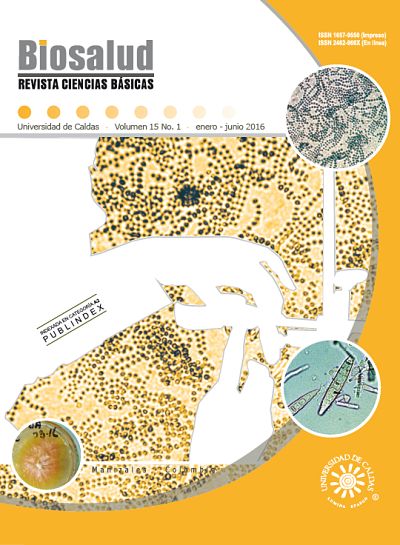Authors
Abstract
The fungus Cryptococcus neoformans is the cause of cryptococcosis in humans and animals. The disease has been linked to the exposure of patients to excreta of birds, of which the urban pigeon (Columba livia) is the most important reservoir of the fungus. Objective: Isolating C. neoformans in pigeon feces in the urban area of the municipality of Pasto (Colombia). Objetive: To isolate C. neoformans on stool of pigeons (Columba livia) in the municipality of Pasto, Colombia. Materials and methods: A descriptive transversal study was carried out in areas with high density of pigeons and great number of people. The areas included the churches located within the city which met the inclusion criteria. A culture of 128 samples of pigeon stool was performed on Sabouraud Dextrose Agar with chloramphenicol. Subsequently, a spread of thin layer of the culture where the pathogen grew was carried out and a drop of India ink was added to visualize the agent in the microscope. The variables analyzed were: presence of C. neoformans on pigeon stool and prevalence of the fungus in sampling areas, characteristics of the sample, and characteristics of the areas in which the agent was isolated. Results: The prevalence of C. neoformans within the municipality of Pasto town was 90%. Out of the total samples collected, 26.56% were positive. Significant relationship between the presence of the agent and the variables of the sample was found (p = 0.0025), fresh sample (p = 0.004), wet sample (p = 0.031), dry sample (p = 0.001), sample without contamination (p = 0.01), high light exposure (p = 0.016), low humidity of area (p = 0.001) and pigeon density (p = 0.007). The study allowed establishing the presence of C. neoformans on pigeon stool in the municipality of Pasto. Particular characteristics were found in the area and the sample which increase the likelihood of isolation.
Keywords
References
2. Quintero E, Castañeda E, Ruiz A. Distribución ambiental de Cryptococcus neoformans en el departamento de Cundinamarca - Colombia. Rev Iberoam Micol 2005; 22:93-98.
3. Pollock C. Fungal diseases of columbiformes and anseriformes. North Am Vet Clin Exot Anim 2003; 6:351-361.
4. Rosario I, Acosta B, Colom F. La paloma y otras aves como reservorio de Cryptococcus spp. Rev Iberoam Micol 2008; 25:13-18.
5. Evans E. Zoonotic diseases of common pet birds: Psittacine, Passerne, and Columbiform Species. North Am Vet Clin Exot Anim 2011; 14:457-476.
6. Curo M. Salinas M, Casquero J. Cryptococcus neoformans en excretas de palomas, suelo y aire de los palomares del perímetro urbano de Ica. Rev Perú Med Exp Salud Pública 2005; 22(4):262-266.
7. Arredondo C. Cryptococcus neoformans en heces de palomas recolectadas en lugares públicos de la ciudad de Santiago, Chile. [Tesis de Grado]. Santiago de Chile: Facultad de Medicina Veterinaria, Ciencias Agrarias y Forestales, Universidad Iberoamericana de Ciencias y Tecnología; 2006.
8. Pita F. Determinación del tamaño muestral. Cad Aten Primaria 1996; 3:138-144.
9. Xiaorong L. Cryptococcus neoformans: Morphogenesis, infection, and isolated. Elsevier Genetics and Evolution 2009; 9:404-424.
10. Caidedo L. Cryptococcus neoformans en excretas de palomas del perímetro urbano de Cali. Colombia Médica 1996; 27:106-109.
11. Ayala D, López F, Valencia R. Aislamiento de Cryptococcus neoformans en muestras del ambiente contaminadas con excrementos de palomas en diferente zonas en el salvador. Minerva Revista en Línea CIC-UES 2011; 2(1):21-27.
12. Cabañes J. Micosis y Zoonosis: Cryptococcus spp. Rev Iberoam Micol 2008; 25:1-3.
13. Vergara C, Quilez J. Criptosporidiosis: Una zoonosis parasitaria. MVZ-Córdoba 2004; 9(1):363-372.
14. Castañeda E. En búsqueda del hábitat del Cryptococcus var. gattii en Colombia. Rev Acad Col Cienc Microb 2001; 25(94):105-114.
15. Baró M. Caracterización de los aislados de Cryptococcus neoformans. [Tesis Doctoral]. Barcelona: Departamento de Genética I Microbiología, Universidad Autónoma de Barcelona; 2002.
16. Casadevall A, Steenbergen J, Nosanchuk J. ‘Ready made’ virulence and ‘dual use’ virulence factors in pathogenic environmental fungi: The Cryptococcus neoformans paradigm. Curr Opin Microbiol 2003; 6(4):332-337.
17. Colom F, Alberdi M, Inmaculada M, Torres J. Aislamiento de Cryptococcus neoformans en muestras de medio ambiente de Alicante. Rev Iberoam Micol 1997; 14:63-64.
18. Harlim R, Wade L. Bacterial and parasitic diseases of columbiformes. North Am Vet Clin Exot Anim 2009; 12:453-473.

 pdf (Español (España))
pdf (Español (España))
 FLIP
FLIP


















